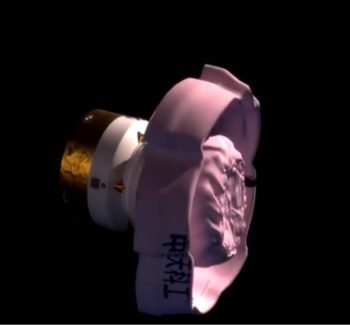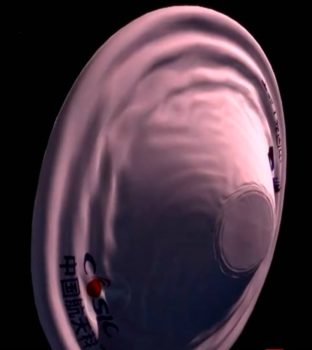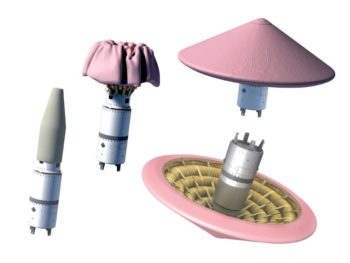China’s recent triumph in testing an unpiloted new-generation crew capsule included a technology development failure. A Flexible Inflatable Cargo Re-entry Vehicle was also onboard the Long March 5B booster and was to return to Dongfeng landing field in Inner Mongolia Autonomous Region.
The device, flown for the first time, is intended to eventually deliver to Earth hardware and science experiments ejected from China’s future space station.
However, the vehicle operated abnormally during its transit to the ground. Experts have been analyzing the relevant data to help reveal what went wrong, according to the China Manned Space Agency.
Similarities to NASA design
It appears that China based their design on NASA’s Inflatable Reentry Vehicle Experiment (IRVE-3), explains Dr. F. McNeil (Neil) Cheatwood, NASA Senior Technologist for Planetary Entry, Descent, and Landing at the space agency’s Langley Research Center in Hampton, Virginia.
“Same diameter, cone angle, pink thermal protection system…even the smaller minor diameter for our outermost torus,” Cheatwood told Inside Outer Space.
Technology demonstrator
On July 23, 2012, a Black Brant XI sounding rocket launched the IRVE-3 payload, encased in a nose cone, from NASA’s Wallops Flight Facility on Virginia’s Eastern Shore. The rocket soared 288 miles (463 kilometers) up and released IRVE-3 into space.
The technology demonstrator inflated, reentered the atmosphere, and fell safely back to Earth — cameras and temperature and pressure sensors monitoring its performance all the way down.
After a total flight of 20 minutes — from launch to splash down — it landed in the Atlantic about 100 miles (160 kilometers) east of Cape Hatteras, North Carolina.

In a pre-flight test, engineers check out the Inflatable Reentry Vehicle Experiment (IRVE-3) in the Transonic Dynamics Tunnel at NASA’s Langley Research Center in Hampton, Va.
Credit: Sean Smith, NASA
Materials development
IRVE-3 is part of the Hypersonic Inflatable Aerodynamic Decelerator (HIAD) Project within the Game Changing Development Program, under the wing of NASA’s Space Technology Mission Directorate. The HIAD Project is based at NASA’s Langley Research Center and has been conducting materials development and flight tests since 2004.
NASA’s Cheatwood is the HIAD Project principal investigator.

After Long March 5 boost into space, China’s Flexible Inflatable Cargo Re-entry Vehicle was to land in Inner Mongolia Autonomous Region. Credit: CCTV/Inside Outer Space Screengrab
Publicly available information
“In one article, the Chinese cite a 2014 start for their development,” Cheatwood says. “For reference, IRVE-II flew in 2009 and IRVE-3 in 2012. And we got the idea for our HIAD technology from the Russians before that…but ours is a very different implementation.”
Based on published descriptions of the Chinese reentry attempt, it appears that they used publicly available information to build a vehicle similar in design to IRVE-3. However, the Chinese were unable to recreate the success of NASA’s flight, Cheatwood notes.

China’s Flexible Inflatable Cargo Re-entry Vehicle operated abnormally during its transit to the ground.
Credit: CCTV/Inside Outer Space screengrab
“Without further information about the as-built vehicle and the flight data,” Cheatwood adds, “we can only speculate as to why their vehicle failed.”
Next NASA flight test
As for NASA’s continued HIAD development, things are proceeding for a next flight test.
“This time we’ll be coming in from low Earth orbit at about 3 times the velocity of IRVE-3. That gives us an order of magnitude more energy to manage. We are a secondary payload on NOAA’s Joint Polar Satellite System-2, launch, scheduled for March 2022,” Cheatwood points out.





